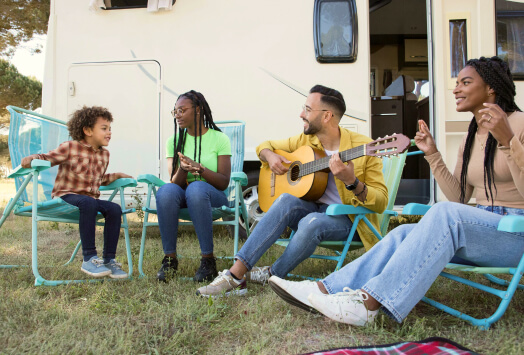Looking for ways to keep your children sane during lockdown? All you need is this guide and a deck of playing cards.The following card games for children are a stimulating way for your young ones to build problem-solving skills and learn how to get along with others. Besides that, they're fun for all ages!
Play them together as a family or let your little ones play them when you need to work at home. Either way, use this guide to teach these simple card games to your children.
1. War (2 Players)
This classic game is a favorite among children everywhere — and fun for adults, too. It's eventful, exciting, and super-easy to learn and play.
You’ll familiarize younger players with the value of numbers (greater-than vs less-than). Plus, it's great for teaching good sportsmanship. That is, it's based entirely on luck, not skill, so there's no reason for arguments to arise (...so we think).
How to Play War
Shuffle and split the deck evenly between the two players. On each turn, both players place the top card from their deck face-up in front of them. The player with the higher value card (ace is highest) takes both cards and puts them at the bottom of his/her deck. But if the two cards match, it's War!
Now, each player places the next three cards from their deck face-down behind their played card. One more card is played by each to determine who wins the war. The winner takes all the played cards and adds them to the bottom of their deck. Although, it's possible that the cards will match again, leading to double war, triple war, and so on. The game ends when one player is out of cards.
2. Go Fish (2 or More Players)
Unlike war, go fish involves strategy as well as luck. The object is to get rid of all cards in your hand by obtaining matching sets and discarding them. But beware. This is an honor-system-based game so cheating can occur.
How to Play Go Fish
The dealer deals each player 7 cards (5 cards if there are more than 3 players). The rest of the cards are scattered face-down on the table as a draw pile known as the "fish pond."If any player at this point already has a matching set (4 of the same number), they may discard it face-up on the table. Otherwise, the player left of the dealer takes their turn.
To get matching sets, the player must ask other players for a specific card that matches the value of a card in their hand. If the player being asked does have one or more of the requested card, they must pass the card(s) to the player who asked. If not, they say, "Go Fish," and the requester must draw a card from the fish pond.
Play continues clockwise, making sure players place completed sets face-up in front of them. The first player to have no single cards left wins! Alternatively, you can play until all sets are completed. The player with the most sets wins.
3. Old Maid (2 or More Players)
Old Maid is similar to Go Fish in that you take other players' cards to create matching pairs. The twist is that instead of ending with one winner, the game ends with one loser.
How to Play Old Maid
Before starting, remove the Queen of Clubs from the deck. This designates the matchless Queen of Spades as the "Old Maid." Deal all cards out to the players, one at a time, until all are dealt. It doesn't matter if players start with different amounts of cards. Each player removes matching pairs from their hand (same color and number) and places them face-up on the table.
Play goes clockwise, starting left of the dealer. The starting player fans out their entire hand face-down and lets the player to their left remove one at random. The game continues until all cards are matched, except one. The player holding the "Old Maid" loses the game.
4. Crazy Eights (2 or More Players)
Crazy Eights is the exact same game as Uno, but with regular playing cards and slightly altered rules. Since most of us are familiar with the rules of Uno, this is a great game to play if you're stuck somewhere without your Uno deck!
How to Play Crazy Eights
Deal 5 cards to each player and leave the rest as a draw pile in the center of the table. Place the top card from the draw pile beside the draw pile face-up. This is the discard pile. The first player must play onto the discard pile one of their own cards (face-up) that matches the number or suit of the first discarded card. If they have no playable cards, they must draw from the draw pile until they can play.
Eights are an exception. They're wild cards you can place on any other card. The rules about what you can play after an 8 card are subject to debate. Some say you ignore the 8 card and play off the previous card. Others use Uno rules and say the player who played the 8 can choose what suit goes next. It's up to you! To spice things up, you can also endow other cards with special rules if you want. The first player to empty their hand wins.
5. Memory/Concentration (2 or More Players)
Memory, AKA Concentration, is arguably the simplest card game there is. And yet, mental training games like these are known to improve memory, language and reasoning skills, and even IQ.
How to Play Concentration
Lay the entire deck face-down in an orderly, rectangular grid. Take turns flipping over cards looking for matches (same color and value). If you find a match, set it next to you, face-up. If not, flip both cards back over in the same spot where you found them. When all matches are made, players count their pairs to see who wins. Improve your memory skills and have fun!
6. Pig (4-13 Players)
Pig is like the card game equivalent of Duck, Duck, Goose. It's a simple, fun, speed-based game with very quick rounds.
How to Play Pig
First, go through the deck and remove one four-of-a-kind (four cards of the same value) for each player. Use these matching sets of four and set aside all the other cards. Shuffle the matching sets together and deal four cards to each player. Next, each player passes a card to their left while taking a card from their right. There are no turns in Pig. All players play in unison and as quickly as possible.
The first player to obtain a matching four-of-a-kind stops passing and touches their nose. The remaining players must also stop and quickly touch their nose. The last player to touch their nose gets a "P." If they lose another round, they get an "I." The first player to lose their third round gets the "G." They are the Pig and they lose the game.
Let Your Family Enjoy These Card Games For Children
Next time you have a few minutes, share these card games for children with your family. Keep this guide for reference in case you forget the rules. Looking for more activities to do at home as a family? We have an article for that. Check out these great at-home family activities next.
















